Guitar
This is a fairly straight forward refinish of a stripped Fender Precision bass body in one of Fender's classic 1960s custom colors, Lake Placid Blue.
As with all of the Fender custom colors of the 60s, Lake Placid Blue was originally a car color for the 1958 Cadillac model year, and was formulated as a Lucite brand acrylic lacquer. For this project I actually used Duco acrylic lacquer because its what was available - I don't believe there's any difference in appearance.
The bass itself was a "frankenbass" - it started out as a 1976 Fender Precision bass, but the owner swapped out the body because it was ridiculously heavy for a more recent Fender alder body (from the 90s I believe). The pickups were custom made grey bottom pickups and the rest of the hardware was a mix of original and reissue parts.
Lake Placid Blue was last available during the 1973 model year from Fender, but 73 and 76 Fender P-basses are generally very similar in appearance (the thumb-rest moved) - so a 76 P-bass in Lake Placid Blue isn't "correct" but the look wouldn't be glaringly incorrect. And give the mix of parts on the instrument, originality wasn't really a concern.
The alder body had been stripped but had a worn clear coat on it, with a deep area of buckle rash on the back, as well as the usual assortment of gouges and dings.
After a sanding of the front and back using a random orbital sander and a 150 grit pad, I used unthinned nitro lacquer to fill in the area of buckle rash as much as possible. I also applied lacquer to some of the other scratches and edge dings.
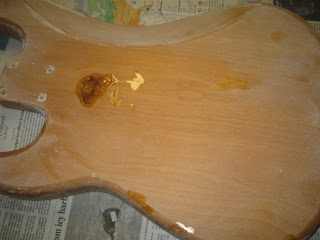
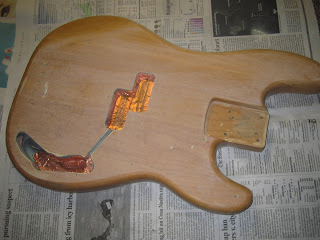
It took about three applications of lacquer on the back to fill in the buckle rash, but once it was hardened, I sanded the entire body down with 220 grit paper and a 220 grit pad on the sander. I applied a heavy clear sealer coat of nitro cellulose after this, in preparation for primer.
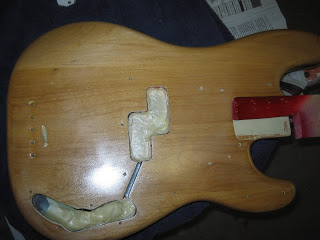
After another light sanding - the body was ready for white nitro primer. The body required a two coats with wet sanding between coats - and a little glazing putty on a few spots here and there. But after the second coat, the body was ready for the color coats.
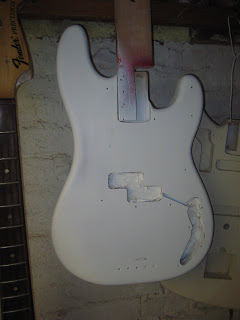
Lake Placid Blue has a fairly heavy metal powder content (I believe its aluminum) - which not only requires very thorough mixing of the paint before use, but also means that the paint is very unforgiving if the paint pools or runs at all, as the silver powder pigment will not dry evenly within that area of the finish. If this occurs, its necessary to wet sand the area down and then respray - usually just best to do the whole back or front over again to ensure an even color.
The way to avoid this problem is to gradually build up the color - which requires patience, since the impulse is to get the color as deep as possible as fast as possible. The pictures below illustrate the first misting coat (sorry they're a little blurry!)
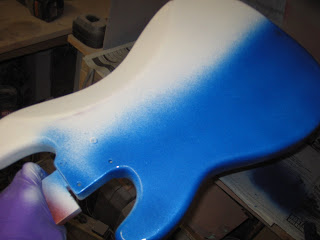
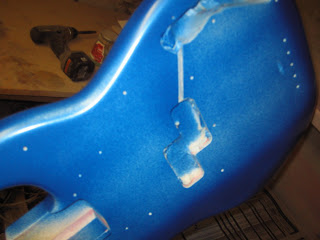
Gradually the color was built up - two more coats of color were applied, with each coat consisting of about 3 passes with the spray gun.
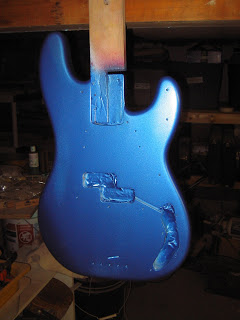

The final step was to add several clear coats to not only protect the color coat, but to also deepen the color and gloss of the finish.
Two coats of clear gloss lacquer with an amber tint were applied, to slightly "age" the finish. I did not yellow the finish to the extent that a true 60s finish would have aged - this would have made the guitar turn to a greenish-aqua color.

Finally, two more coats of clear untinted nitro was sprayed on the body. Once everything had dried and hardened for roughly a week and a half, I wet sanded and then buffed out the body, with my usual procedure - finish off with a vigorous hand buffing using Meguire's Scratch-X.
I assembled the bass with the black guard the owner had on the bass, though when he showed up we installed an aged white guard, which looked much much better. Unfortunately we were in a rush and I forgot to snap some pictures (I'll try to get some from him eventually).

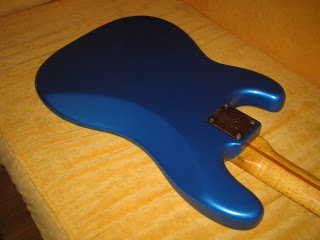
Watch for an upcoming project in which I refinish my 1966 Jazz bass to match the original aged Lake Placid Blue headstock.
- 1968 Fender Jazz Bass: Sonic Blue Regret And Restoration
This project represents an unfortunately common scenario from the 1970s, where an instrument's owner decided that the "natural" look was preferable to the original factory custom color. Guess the attitude was that "wood was good" - during this...
- 1966 Fender Jazzmaster: Aged Olympic White
< A fairly straightforward project here - a 1966 Fender Jazzmaster body that had been poorly refinished over the years and that the owner wanted to do in an aged Olympic White finish. The original Olympic White is a color thats seldom seen - its a bright...
- Radical Ibanez Roadstar Bassmod, In Daphne Blue
Here's a project I just started a few days ago - for a client from the local "Bassment" forum. This started out as an Ibanez Roadstar 2 Bass - presumably from the 80s. As you can see from a picture of the bass before any mods, it was a fairly conventional...
- 1971 Fender Precision Bass Refinish In Sonic Blue !!!
Another Fender Precision Bass project - an older maple board P-bass that has been through some changes, namely, the body has the classic added Jazz bass pickup at the bridge route, plus a route to sink a BadAss 1 bridge into the top and of course, a route...
- G&l Asat Bass Refinish
Ok some of you may wince, because this bass had a very nicely done factory cherry sunburst finish when I started on it, but the owner simply didn't like it and wanted something brighter and louder and more ... ORANGE !!! This is a very cool bass -...
Guitar
1976 Fender Precision Bass: Refinish to Lake Placid Blue - a classic 60s color!
This is a fairly straight forward refinish of a stripped Fender Precision bass body in one of Fender's classic 1960s custom colors, Lake Placid Blue.
As with all of the Fender custom colors of the 60s, Lake Placid Blue was originally a car color for the 1958 Cadillac model year, and was formulated as a Lucite brand acrylic lacquer. For this project I actually used Duco acrylic lacquer because its what was available - I don't believe there's any difference in appearance.
The bass itself was a "frankenbass" - it started out as a 1976 Fender Precision bass, but the owner swapped out the body because it was ridiculously heavy for a more recent Fender alder body (from the 90s I believe). The pickups were custom made grey bottom pickups and the rest of the hardware was a mix of original and reissue parts.
Lake Placid Blue was last available during the 1973 model year from Fender, but 73 and 76 Fender P-basses are generally very similar in appearance (the thumb-rest moved) - so a 76 P-bass in Lake Placid Blue isn't "correct" but the look wouldn't be glaringly incorrect. And give the mix of parts on the instrument, originality wasn't really a concern.
The alder body had been stripped but had a worn clear coat on it, with a deep area of buckle rash on the back, as well as the usual assortment of gouges and dings.
After a sanding of the front and back using a random orbital sander and a 150 grit pad, I used unthinned nitro lacquer to fill in the area of buckle rash as much as possible. I also applied lacquer to some of the other scratches and edge dings.
It took about three applications of lacquer on the back to fill in the buckle rash, but once it was hardened, I sanded the entire body down with 220 grit paper and a 220 grit pad on the sander. I applied a heavy clear sealer coat of nitro cellulose after this, in preparation for primer.
After another light sanding - the body was ready for white nitro primer. The body required a two coats with wet sanding between coats - and a little glazing putty on a few spots here and there. But after the second coat, the body was ready for the color coats.
Lake Placid Blue has a fairly heavy metal powder content (I believe its aluminum) - which not only requires very thorough mixing of the paint before use, but also means that the paint is very unforgiving if the paint pools or runs at all, as the silver powder pigment will not dry evenly within that area of the finish. If this occurs, its necessary to wet sand the area down and then respray - usually just best to do the whole back or front over again to ensure an even color.
The way to avoid this problem is to gradually build up the color - which requires patience, since the impulse is to get the color as deep as possible as fast as possible. The pictures below illustrate the first misting coat (sorry they're a little blurry!)
Gradually the color was built up - two more coats of color were applied, with each coat consisting of about 3 passes with the spray gun.
The final step was to add several clear coats to not only protect the color coat, but to also deepen the color and gloss of the finish.
Two coats of clear gloss lacquer with an amber tint were applied, to slightly "age" the finish. I did not yellow the finish to the extent that a true 60s finish would have aged - this would have made the guitar turn to a greenish-aqua color.
Finally, two more coats of clear untinted nitro was sprayed on the body. Once everything had dried and hardened for roughly a week and a half, I wet sanded and then buffed out the body, with my usual procedure - finish off with a vigorous hand buffing using Meguire's Scratch-X.
I assembled the bass with the black guard the owner had on the bass, though when he showed up we installed an aged white guard, which looked much much better. Unfortunately we were in a rush and I forgot to snap some pictures (I'll try to get some from him eventually).
Watch for an upcoming project in which I refinish my 1966 Jazz bass to match the original aged Lake Placid Blue headstock.
- 1968 Fender Jazz Bass: Sonic Blue Regret And Restoration
This project represents an unfortunately common scenario from the 1970s, where an instrument's owner decided that the "natural" look was preferable to the original factory custom color. Guess the attitude was that "wood was good" - during this...
- 1966 Fender Jazzmaster: Aged Olympic White
< A fairly straightforward project here - a 1966 Fender Jazzmaster body that had been poorly refinished over the years and that the owner wanted to do in an aged Olympic White finish. The original Olympic White is a color thats seldom seen - its a bright...
- Radical Ibanez Roadstar Bassmod, In Daphne Blue
Here's a project I just started a few days ago - for a client from the local "Bassment" forum. This started out as an Ibanez Roadstar 2 Bass - presumably from the 80s. As you can see from a picture of the bass before any mods, it was a fairly conventional...
- 1971 Fender Precision Bass Refinish In Sonic Blue !!!
Another Fender Precision Bass project - an older maple board P-bass that has been through some changes, namely, the body has the classic added Jazz bass pickup at the bridge route, plus a route to sink a BadAss 1 bridge into the top and of course, a route...
- G&l Asat Bass Refinish
Ok some of you may wince, because this bass had a very nicely done factory cherry sunburst finish when I started on it, but the owner simply didn't like it and wanted something brighter and louder and more ... ORANGE !!! This is a very cool bass -...
